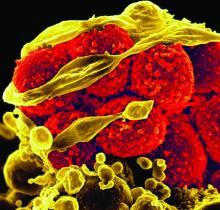, according to Dr. John Bradley of the University of California, San Diego, and his associates.
A total of 389 cSSSI patients were included in the study, with 257 receiving daptomycin and 132 receiving standard-of-care (SOC) treatment (mostly vancomycin or clindamycin). Clinical success rates were similar for both groups, at 91% in the daptomycin group and 87% in the SOC group. Therapeutic success rates also were similar, at 97% in the daptomycin group and 99% in the SOC group.
“Daptomycin is a suitable once-daily alternative to vancomycin or clindamycin in the pediatric setting, particularly for suspected or confirmed MRSA [methicillin-resistant Staphylococcus aureus] infections,” the investigators concluded.
Find the full study in Pediatrics (doi: 10.1542/peds.2016-2477).


